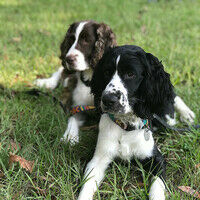When there are a bunch of instruments playing together and one of the instruments plays the same note twice - especially in a fast tempo'd piece, the odds are you will not 'hear' both notes played - even if they are short (i.e., staccato). The two notes may sound to your audience as a single note. So I would ask you, do you really need both notes? Perhaps there is a good reason for it - but once you have written your piece, it's time to go through your score and 'prune' - every note has to be justified. Don't hold on to your notes just because you wrote them - especially the double ones. As you add instruments, odds are you will need to have multiple instruments playing the same note (we call it 'doubling' or 'tripling', etc.). So if you have an instrument playing the same note twice and it turns out that other instruments are also playing that note, you may want to consider pulling out the doubled note (i.e., change it to a rest). I just looked at a string quartet I am writing (two violins, viola and cello). The tempo is rather fast 12/8 at 120 bpm (beat equals dotted quarter). I went through the first 20 bars and found at least 15 doubled notes I just 'had to have' as extraneous and pulled them out and the result was a better 'sound' with more defined instrumentation. Works the same way for soundtracks and cues. Thicker is not necessarily a better sound. My mentor who looks at much of my work is constantly 'yelling' at me to pull notes out - he keeps telling me "don't get married to your notes". So start with the instrument or instruments that carry your melody at any point and justify all your notes - especially the ones that are the same as the ones before them. Then look at the instruments carrying your tempo - often you may see patterns of repeated notes (especially in the lower instruments like cello, bass, trombone, tuba and bassoon). Repeating the notes are often done in these lower supporting instruments to establish and carry a rhythm. Many composers do that because they come from pianos/keyboards which play solo and they use their left hand to establish a rhythm. But when you write for ensembles, the rhythm can be inherently 'builtin' to all the instruments and so the listener can ascertain a 'beat' with your music even if you don't specifically establish that beat with your instruments - so if you have say 12/8 and see the same 1/8th note staccato'd 12 consecutive times - ask yourself do you really need to do that? Perhaps yes or perhaps not - the point is you should look at it and then question why its there and decide.



brandi - sharper sounds like from trumpets or horns tend to help though they can also get you in the romantic mood and slow down if the same sounds are held for long periods.
Thanks Joel. Great advice! I call it subtractive composition. I always find it useful too, in shaping melodies and adding space, that also goes for orchestration as well. It's just like adding stops on an organ or under laying textures with a synth. You must be cognizant of the texture pallet, intonation and volume when doubling certain notes... best example is looking at music of Reich or Adams or Arvo Part, they are the masters of tonal doubling, and on the scoring side, JW's orchestration , and Hans with his synth doubling.